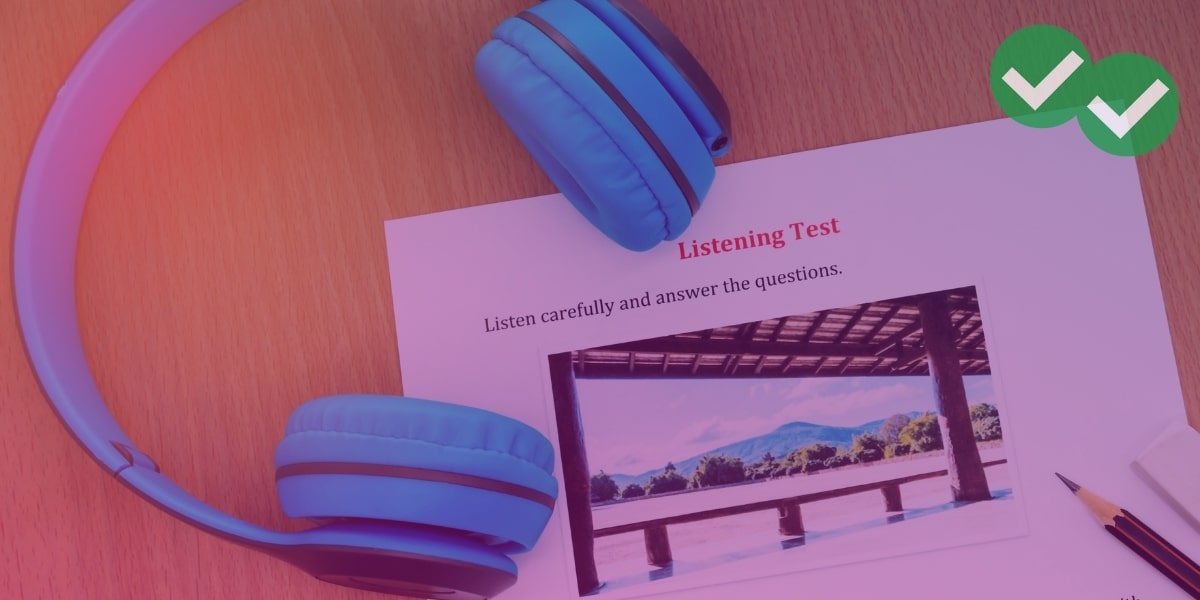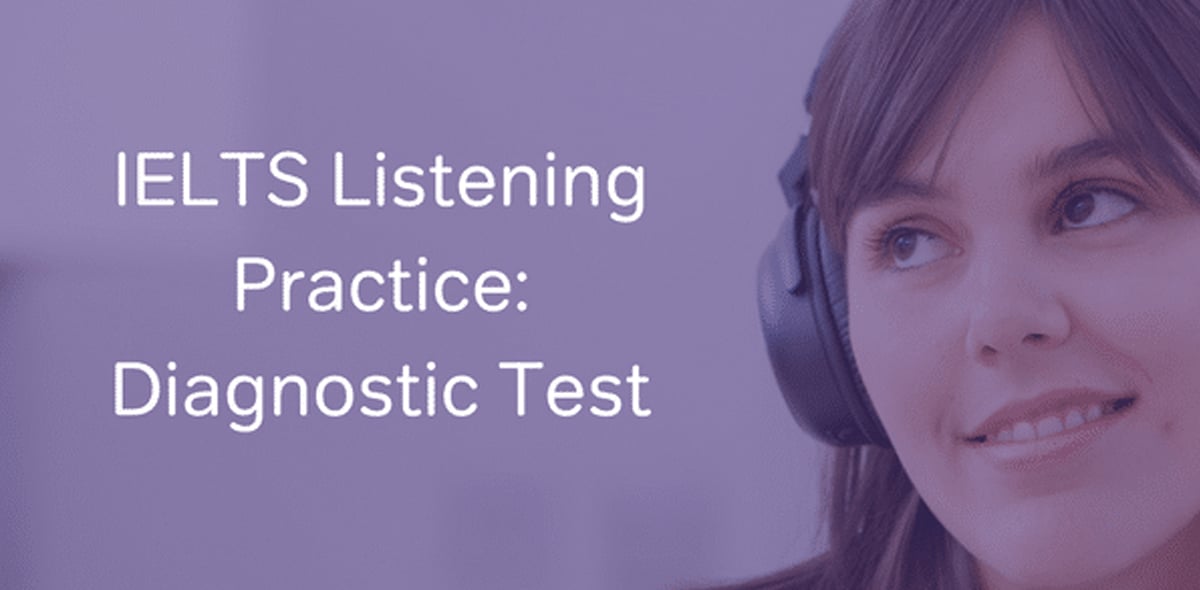
If you want to master the IELTS Listening question types, strategies, and whole section, then you’ve come to the right place. Read on for everything you need to know about Listening practice material, format, timing, and more. Plus, we’ll give you some expert tips and tricks to get a top IELTS Listening score!
Table of Contents
- IELTS Listening Practice Tests and Resources
- How is the IELTS Listening test conducted?
- IELTS Listening Question Types
- Tips and Tricks for IELTS Listening
- More Resources for IELTS Listening Prep
IELTS Listening Practice Test and Resources
To prepare well for the Listening portion of the exam, you’ll need quality practice tests. When taking a sample test, incorporate as many real test constraints as you take them. For example, don’t start and stop the recording or listen to the recording more than once. To start, we recommend checking this set of free online IELTS Listening practice tests and sample tasks.
In addition to those practice tests, we offer a number of other general resources that can help you prepare not just for the Listening section, but also for the exam as a whole:
- Our free IELTS Practice Test
- To find a good IELTS textbook with practice exams (and other high-quality IELTS study materials), see our recommended books and resources.
- IELTS Listening Practice Test video. This one is also on our free IELTS Listening practice test post, but I wanted to highlight it here because it’s a really great simulation of a full section with an online timer!
As you go through these kinds of Listening practice materials, closely study the recordings when you review your answers and make sure to use the transcripts as you do so (most practice materials will provide a transcript of the Listening materials). Study them. Make sure to understand each mistake you made, and keep track of new vocabulary.
Don’t limit yourself to practice tests, however. You should listen to a wide variety of material in your IELTS preparation, including English listening beyond IELTS material. Here is a good list of listening materials you can use:
- TED Talks
- This I Believe podcasts from NPR
- Listen and Watch from the British Council
- BBC Radio
- ABC News (Australia)
- Additional Australian listening resources from Magoosh’s TOEFL blog.
How is the IELTS Listening test conducted?
Next, let’s look at the general structure of IELTS Listening: how this section works and what’s in it.
Academic vs. General IELTS Listening
Is IELTS Listening the same for Academic and General? The good news here is that there are no differences between IELTS Academic Listening and IELTS General Listening. The IELTS Listening section is the same for the Academic and General Training versions of the test. So you can prepare in the exact same way no matter which variation of the exam you take! (Only the Reading and Writing sections differ between the two.)
Timing
IELTS Listening takes about 40 minutes total. If you are one of the many students taking the IELTS on paper, around 30 minutes of this section will be listening to recordings and answering questions in your Question Booklet, where you’ll find the instructions and questions. This Booklet is separate from the official Answer Sheet (PDF). After the final recording, you’ll have 10 minutes of “transfer time” to copy your answers from your Question Booklet to your Answer Sheet. Only the answers you write on your Answer Sheet will be marked.
Use this transfer time to your advantage. You don’t need to record your answers in the Answer Sheet until the allotted transfer time at the end. Use this time to write carefully and neatly — graders need to be able to read your writing! Misspellings are marked incorrect, so use this time to also double-check the spelling.
Format
You’ll hear four different Listening passages on the Listening exam, and answer 10 questions in each section (40 total). The passages come in the form of four separate recordings, and they get tougher as you progress through the exam.
Passage 1: This is usually a conversation between two people. Typically, the conversation will involve a basic exchange of information in everyday context (business interactions, job training contexts, etc…). For example, someone might be placing an order over the phone, or confirming details for a reservation. The topic will be a daily-life situation.
Passage 2: This is usually a monologue (one person speaking). Passage 2 will also come from a common daily situation, a very general topic. For example, you might hear someone providing directions, or presenting basic information about a place or an event.
Passage 3: The topics become noticeably more challenging in Passage 3. This will be a conversation, often among several people, about an academic topic. You might hear a few students discussing something from class, or a professor providing feedback about an assignment, for example. Passage 3 is tougher because the vocabulary is more difficult, the topics are more complicated, and there are more speakers involved in the discussion.
Passage 4: This will be a university lecture from a professor. It could cover any topic from a typical college course. You are not required to have specialized knowledge about the academic subject matter. However, the language will be difficult, and the lecture will be complex. This is the toughest passage on the Listening exam for most students.
Scoring for IELTS Listening
The Listening section has a pretty simple scoring system. Each question is worth 1 point, so you can achieve a “raw” score up to 40 points which is then converted to a band score. (See Magoosh’s IELTS score calculator to convert your raw Listening score to a band.) This IELTS Listening rubric breakdown will help you understand what each band means more specifically. Because your band is based on your raw score, you’ll want to treat each question from Section 1 onwards with the same weight.
IELTS Listening Question Types
There are six basic question types in the IELTS Listening section. For a practice set of each question type, click the button below to download Magoosh’s IELTS Listening Question Types PDF.

And for a description of each of the IELTS Listening question types, see below:
IELTS Listening Question Type: Short Answer
Click here to learn all about short answer questions.
For this question type in particular, it’s critical that you make sure you read and follow the directions. This question type comes with very clear word and number requirements — whatever you do, follow them! Moreover, you will often have to find detailed information related to some category.
The Sentence Completion IELTS Listening Question Type
Click here for more info on this question type.
It’s helpful to think about Sentence Completion questions as a form of Short Answer questions. So, once again, pay attention to the instructions — this is where you can easily lose points!
For this question, you’re going to complete a sentence and will almost always be a paraphrase of something you heard in the conversation or lecture. So, don’t expect to hear an exact word-for-word match with the question. Prepare to think and use synonyms.
These sentences are full of important information that can help you predict the answers. Pay close attention to the grammatical structure of the sentence and the information that’s missing. Is it a noun, a verb, an adjective, and so on?
The Plan, Map, and Diagram Completion IELTS Listening Question Types
Click here to learn about these IELTS Listening question types.
These questions involve some sort of visual — be it a plan, a map, or a diagram. These visuals will have some missing labels. The questions will have you fill out those missing labels based on what you’ll have listened to.
These visuals include a lot of clues. For instance, suppose you received a Map Question. Look at the location of the first question, and then look at the map to see where the following questions are located. The questions are asked in the order of what is discussed by the speaker(s). So, you can begin to anticipate the sort of things you’ll need to listen for.
You can also study the map to familiarize yourself with the location of other items. For example, perhaps the map includes a statue, a restaurant, or some other landmark. You can use this to anticipate the sort of things you’ll want to pay attention to. Getting familiar with the Map, Plan, or Diagram before you listen to the speaker will help you get oriented.
Matching in IELTS Listening
Click to expand the description of Matching questions in IELTS Listening.
Matching Questions usually involve listening for detailed information. It’s important to look at the category of information that you will match to the answer choices. Sometimes you’ll have lettered options, in others you’ll have to fill in a box.
IELTS Multiple Choice Questions
Click for details on multiple choice questions.
IELTS Multiple Choice questions only have 3 possible answers. Sometimes (but not often), there will be more than three answer choices. In this case, you will usually be instructed to choose more than one answer.
You must remember to enter your Answer Sheet with a letter — either A, B, or C. Remember: Don’t write the answer choice word(s)! Sometimes, you will only have two or three Multiple Choice questions in a section. At other times, there could be up to five to eight.
Treat Multiple Choice questions exactly like other question types. In the time provided before you listen to the passage, skim all of the questions and the answer choices to find keywords. Answers will come in order in the passage, so you need Track answers across all of the questions in the task you’re working on.
There’s an important subtype to the Multiple Choice question type that you may not encounter, but is important to know about. This subtype, known as the Main Idea, will require you to be able to articulate the main point of the recording. You can read an in-depth analysis of this subtype here: IELTS Listening Question Type: Main Idea.
Completion IELTS Listening Question Types: Forms, Summaries, Flow-Charts, Tables, Notes
Click for additional information on this family of IELTS Listening question types.
These question types might look very different, but they actually share a lot in common. They are often Short Answer questions, but you may also be presented with a list or a box with answer choices. Basically, you will need to fill in missing information based on the Listening passage.
It’s critical to look at each question number. Notice where it is located on the visual or summary and what the keywords are that surround it. You should “track” these keywords as you listen to the speaker.
Here’s a quick overview of the different types of completion questions that you might encounter on the IELTS Listening section:
- Flow Chart Completion Questions on IELTS Listening
- This shows steps or stages in a process. You can expect that you will need to listen for the different stages of the process.
- Table Completion Questions in Listening
- It can refer to many things, but often a table is used to categorize several things, so you will need to fill in missing information on the table.
- IELTS Listening: Notes Completion Questions
- This is a common question type for Passage 4, in which you will hear a lecture. You will have incomplete lecture notes that you need to fill in based on what the professor says.
- Summary Completion Questions
- You’ll be presented with a paragraph of several sentences which summarize the listening passage and fill in the blanks based on the talk.
- Form Completion Questions
- This question type is common for Section 1 of the Listening exam, though they can come up in other sections from time to time.
Tips and Tricks for IELTS Listening
Before we get into the rest of the tips and tricks, let’s talk about the directions. You’ll receive many specific directions for different question types. If you fail to follow those directions, you could lose points even if you know the answers. To avoid needlessly missing test questions like that, click below to open up an in-depth set of tips for following directions in IELTS Listening.
Show Tips for IELTS Listening Directions
Attention to detail is very important on the IELTS Listening exam. Unfortunately, too many people lose points unnecessarily because they don’t pay close attention to the directions. Here are some general guidelines to follow:
- Make sure you write the correct type of answer on your final Answer Sheet. For example, on Multiple Choice questions, the correct answer will be a letter (A, B, or C). Sometimes, students mistakenly write the words or numbers that come after the letter on their answer sheet and therefore answer incorrectly.
- Various types of short answer questions are common on the Listening paper. You may need to fill in a summary, a map, some notes, or just listen for some specific words that you must fill in on your answer sheet. The IELTS will always tell you how many words and/or numbers you are allowed to use in your answers. You MUST read the directions for each set of questions because the requirements change. One set of questions may allow a short answer of three words, but the next may only allow two. If the directions tell you that you may not use “MORE THAN TWO WORDS and/or A NUMBER,” then your answer will be marked incorrect if you write down three words, or more than one number.
Note that one number can be more than one digit. For example, the number 14 [fourteen] is one number. 1 and 4, written separately, would be two numbers.
And now, here are links to additional IELTS guides from Magoosh, full of tips and tricks that extend far beyond just following directions:
- IELTS Listening Tips and Strategies
- IELTS Listening Section 4 Tips and Practice
- IELTS Listening Section One Tips and Practice
- How to Read IELTS Listening Questions
- IELTS Listening Accents: What to Expect
- Best Tips for Note Taking on the IELTS
More Resources for IELTS Listening Practice and Preparation
Studying for the IELTS Listening exam is just one part of a good study plan. Make sure you have all the resources you need to achieve your target band score for the whole IELTS test! Magoosh offers IELTS Prep video lessons to help you on the Listening section, but the lessons cover the other IELTS sections as well. (And paid subscribers also have access to tutor assistance via email!)
Many students who need guidance with Listening also need some assistance with IELTS writing. Here are some Guides to IELTS Writing Task 1 and Task 2 to help you prepare for this difficult portion of the exam.
Finally, depending on how much time you have before you take the IELTS, this one-month study schedule can help you stay organized. If your prep time for the IELTS exam is more limited, go over to the web page for our one-week schedule!
Best of luck, and happy studying!





